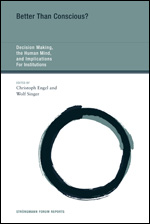Group 1: Exploring the Strategies of Decision Making
- Conscious vs. Intuitive Strategies
- The Role of Explicit and Implicit Experience
- The Role of Emotions and Learned Rules
- The Sources of Information Used in Rational and Intuitive Decision Processes
Fairly small computers are able to outperform untrained humans in conscious logical operations. This fact suffices to demonstrate that human dominance of the world cannot exclusively be explained by the human ability of conscious rational reasoning. One powerful explanation is "smarter, not harder." Instead of going through a nightmare of calculations, humans often use rules of thumb. But this cannot be the entire truth.
There is indeed evidence, both from primates and from humans, which indicates that the brain relies partially on brute computational force. This massive parallel processing, however, does not happen at the conscious but rather at the subconscious level. In addition, it is not disjoint from either rules of thumb or rational reasoning but interacts with both abilities. Specifically, humans rely on a vast knowledge base, and they manipulate large amounts of sensory input, as well as data retrieved from memory, when they engage in judgment and decision making. This helps them, for instance, to assess reliably the ecological validity of rules of thumb, which is what makes them so powerful. It also helps them, when engaged in rational reasoning, to control both process and outcome by way of intuition, which explains, for instance, why the legal profession does a fairly good job, even in contexts that are at best partly understood scientifically.
The mission of this group is to investigate the different strategies of problem solving, i.e., decision making. Can the subconscious abilities come to the rescue of rational choice modeling, rightly attacked by experimental economists on the conscious level? What are the implications for the growing field of behavioral institutional analysis and design? Must the performance of the many mental tools for judgment and decision making be reassessed in the light of their interaction with the subconscious ability of parallel processing?
Group 2: Exploring the Neuronal Mechanisms of Decision Making
- Decisions in the Perception of Ambiguous Patterns
- Forced Choice as a Means to Probe Subconscious Decision Making
- Neuronal Correlates of Decision Processes
- Models of Decision Making in Parallel Distributed Processing
The goal of this group is to examine what we know about the neuronal mechanisms of decision making in animal models and human subjects. This is currently an active field of research that touches upon numerous fascinating questions of self-organizing principles in complex systems with distributed architectures.
Group 3: Exploring the Power of Conscious and Intuitive Decision Making
- Comparing Problem Solving Strategies in Animals and Humans
- Comparing Problem Solving Strategies in Different Cultures
- Strategies to Resolve Conflicts between Intuitive and Rational Solutions
- How do Western Institutions Exploit the Ability of Humans to Reach Decisions in Complementary Ways?
This group should explore to which extent the human ability of exploiting both unconscious and conscious processes for problem solving is reflected in the organization of decision processes. The underlying hypothesis is adaptation. The respective organization would not have evolved, developed, or designed if it ignored the specific strengths of the mental machinery of the organism.
Group 4: Case Study: Judicial Decision Making
- Which Are the Mental Mechanisms Underlying the Intuitive Component in Legal Decision Making?
- How Do Intuitive and Deliberate, Subconscious and Conscious Elements Interact in Legal Decision Making?
- How Do Lawyers Acquire the Mental Abilities Necessary for Judicial Decision Making?
- Do the Legal Orders Differ with Respect to the Prevalent Style of Judicial Decision Making?
More often than not, the distinctions between intuition and deliberation, between subconscious and conscious machinery, between parallel and serial processing are not categorical. Rather, decision modes may be characterized by how they combine both kinds of inputs. There is considerable variation in the combination of these inputs, depending on the perceived character of the task and on the personality of the decision maker. Individuals may develop an idiosyncratic style of decision making. Yet often they basically adopt the decision mode they observe in others. Institutions, not so rarely, aim to bring about such learning.
A rich illustration of this is legal decision making, and judicial decision making in particular. A court is normally not free in how it decides. It is asked to apply the law as it stands. Exceptions like jury decisions or some Islamic courts notwithstanding, judicial decisions must be justified. The justification is not only addressed to the parties, but to the professional community of lawyers as well. This institutional framework pushes lawyers into deliberation. The deliberate element is even more pronounced in the many legal orders that originated in Roman law. Here, the courts do not have the power to generate new rules openly in the light of the case to be decided. It is their task to apply the existing general rules. Practically speaking, in these legal orders, the degrees of freedom originate in two elements: in the facts of the case and in the richness of the doctrinal framework. One must be fairly astute to exploit these degrees of freedom.
Despite the pronounced deliberate element, judicial decision making is not a mechanical exercise. On the contrary, the primary goal of legal education is to teach young lawyers how to recognize the irregular aspects of the specific case. Often, aspects of a case turn out to be decisive for which no neighboring discipline is able to offer stringent language. In other situations, lawyers feel that the available rigorous conceptions are inadequate for their decision making task, e.g., since the price for rigor is assumptions that are strongly counterfactual. Moreover, legal doctrine has so many degrees of freedom that choosing among them is often more important than applying the chosen one lege artis. For all of these reasons, legal decision making is characterized by the interaction between equally pronounced deliberate and intuitive components.
Top of page
![]()
